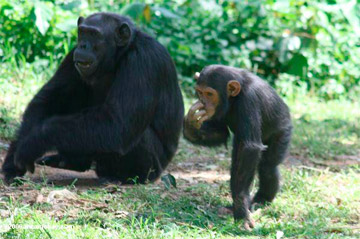You’ve probably seen them: the TV ads showing chimpanzees wearing suits, driving cars, or smoking cigars. These ads may tickle our funny bone, but they warp our perceptions of how chimpanzees are faring in the wild, researchers at Duke University have found.
The study, published October 12 in the journal PLoS ONE, examined whether watching commercials featuring chimpanzees influenced people’s understanding of their endangered status. Until now, “there were no data one way or the other,” said lead author Kara Schroepfer, a graduate student at Duke, in an interview with mongabay.com.
About 170 participants watched a series of videos that included either a chimpanzee entertainment commercial, a chimpanzee conservation commercial, or footage of chimpanzees in the wild (as a control). Then, the authors surveyed viewers about whether chimpanzees were endangered and if they’d make suitable pets. Participants also had the opportunity to donate money earned in the study to a conservation charity.
 A 1963 television special featuring “Jack Benny and the Marquis Chimps.” Photo from CBS. |
Those who watched the entertainment commercial demonstrated a worse understanding of chimpanzees’ endangered status and pet suitability compared with those who saw the conservation commercial or the control footage. The entertainment video group also donated less than half the amounts given by the other two groups to the conservation charity.
The scientists had proposed two hypotheses for the effects the animal ads might have on viewers. The “distortion hypothesis” states that seeing trained chimpanzees in commercials and other media leads people to believe that chimpanzees aren’t endangered and could make good pets. The “familiarity hypothesis” states that any form of media featuring chimpanzees, even in unnatural or human-like settings, helps conservation efforts by familiarizing people with the animals.
The team’s results squarely support the distortion hypothesis: “Putting chimpanzees in a suit will lead people to think they’re not endangered,” said Schroepfer.
Indeed, the familiarity hypothesis isn’t a valid argument in the developed world, where people are already aware of conservation, said Naftali Honig, director of the organization Project for the Application of Law for Fauna, in an interview with mongabay.com. However, he said that media portraying chimpanzees in natural settings might increase awareness in developing countries where wild chimpanzees live. “The bottom line is that for so many aspects of conservation, advertisers need to be aware of what they’re portraying,” Honig said.
 Chimpanzees in Uganda. Photo by: Rhett A. Butler |
An industry representative who spoke with mongabay.com defended the use of trained chimpanzees in ads: “My feeling is there is nothing wrong with using animals if they’re treated kindly and raised nicely,” said Linda Hanrahan of Animals for Advertising Inc. The advertisers whose chimpanzee commercials were used in the study could not be reached for comment.
Other research has shown that anthropomorphic animals as entertainers may have a better place in big-screen animations. Films that feature wild animals, such as the Pixar film “Finding Nemo” and the Dreamworks film “Madagascar,” reach large audiences and may be effective conservation education tools, according to a recent study published in Tropical Conservation Science by researchers in Singapore.
“I do think animated films could play a good role in primate conservation,” said Schroepfer, “as long as they portray wild animals.” Honig agreed: “The key thing is showing animals in the wild.”
Entertainment media also impacts orangutans and other primate species, said David Dellatore, scientific director of the Sumatran Orangutan Society, in an email to mongabay.com. “Yes, oftentimes they look cute,” said Dellatore, “but we have to resist these urges and let our knowledge and respect for life win out.”
CITATIONS: Schroepfer K, Rosati A, Chartrand T, and Hare B (2011) Use of “Entertainment” Chimpanzees in Commercials Distorts Public Perception Regarding Their Conservation Status. PLoS ONE 6(10): e26048. DOI: 10.1371/journal.pone.0026048
Yong, D. L., Fam, S. D. and Lum, S. 2011. Reel conservation: Can big screen animations save tropical biodiversity? Tropical Conservation Science Vol. 4(3):244-253. Available online: www.tropicalconservationscience.org
Tanya Lewis is a graduate student in the Science Communication Program at the University of California, Santa Cruz.
Related articles